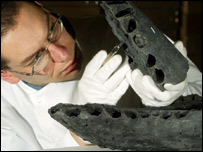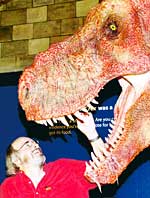A round object discovered in India may be a dinosaur egg

The fossilized bones of a 130-million-year-old marine reptile arrived at a Cambridge museum last Tuesday. Scientists from the University of Cambridge Sedgwick Museum will examine the body of a phyllosaurus, which last swam in the waters that covered Columbia during the age of the dinosaurs.
The bones of the phyllosaurus, a counterpart of the reptile family to the killer whale, were found in excavations in 1967 outside Bogotá and constituted a new species, which scientists had not recognized until that time.
However, the marine reptile, which was four meters long and lived as recently as the Cretaceous era, remains abandoned in the vaults of the National University of Colombia in Bogotá.
The bones were rediscovered four years ago by student Marcela Gomez, who traveled to England.
The skeleton has been loaned to the Sedgwick Museum, where experts will work on separating the bones from the rock, a process expected to take three years. The experts will also study the bones.
Dr Leslie Noh, a palaeontologist at the museum, said: "When I first saw the bones, I was absolutely amazed."
"I immediately noticed that this is a very, very important animal and unknown to science."
"It is important that we work with our Colombian colleagues to understand this fascinating new animal."
Link to the original article
A round object discovered in India may be a dinosaur egg
The object is found in the west of the country, in a place where predatory dinosaurs roamed in the past
26.2.2004
The object discovered in India. In the past, remains of carnivorous dinosaurs were found in the area

About a year ago, archaeologists found parts of a dinosaur skull in the area. Scientists who mapped the findings determined that it was a dinosaur that was about ten meters long and about two meters high. He had two legs and a head covering that was defined as "extraordinary".
The Gujarat government has announced that it intends to establish a park for dinosaur fossils in the region.
Due to a divorce trial, a dinosaur skeleton is found for auction * The price starts at a million dollars
Want a fossilized dinosaur skeleton in your living room? – Paid about a million dollars at an auction

T-Rex at the Natural History Museum in London. Barnum is 68 million years old
Los Angeles. When Japheth Boyce was a toddler in South Dakota, he loved to dig through the arid, barren soil of the Badlands in search of fossils of long-fanged tigers or pygmy horses. Today, as a paleontologist with a special fondness for cowboy hats and an unconventional worldview, he prefers to "hunt" for fossils of the Tyrannosaurus Rex ("T-Rex"), the meat-eating dinosaur that Boyce calls "the biggest bully in the neighborhood."
Yesterday, hundreds of fossilized bones from a 68-million-year-old Te-rex -- excavated by Boyce and his team over two years in eastern Wyoming -- were put up for sale in what was billed as the largest natural artefact auction ever held. According to early estimates, the bones, which make up about 20% of the skeleton of the dinosaur nicknamed "Barnum", were supposed to sell for at least $900.
According to the "Bohnams and Butterfields" auction house, this is the second auction of T-Rex bones in history. In 1997, a dinosaur named "Sue" - found near Fayette, South Dakota, with about 85% of its bones in place, including a 270 kg skull - was sold to the Field Museum in Chicago for $8.36 million.
According to the experts, Barnum is a particularly fascinating case, as it may be part of the first T-Rex ever discovered, which is now housed in the Natural History Museum in London. About a week ago, after talking with the museum staff, Boyce went to London to compare samples of the two individuals.
"As a scientific statement, I say it is the same individual," Boyce said. According to him, Barnum's bones were found in the same plot, measuring five square kilometers, near Newcastle, Wyoming, where the remains from London were found, which were discovered in 1900 and bought by the British Museum in 1960. Boyce added that some of the bone fragments from the two discoveries overlap in terms of size, fit and shape. The British Museum did not respond to a request for comment, but according to Boyce, the museum is simply waiting for the result of an expert examination that will determine if there is a connection between the two discoveries.
The skeleton in London consists of 13.8% of the original bones. If indeed it matches the new discovery, and the two discoveries are combined together - it will be one of the most perfect T-Rex skeletons in the world.
Boyce said he wasn't particularly thrilled when a Wyoming rancher called him in 1995 and said he thought he had found dinosaur bones on his property. When Boyce arrived at the scene - a swampy area infested with mosquitoes - he discovered part of a lower jaw and a neck vertebra, and later dozens more parts. According to him, he immediately recognized these as T-Rex bones.
The satisfaction of discovering the fossils was clouded by a dispute over the ownership of the bones. A similar dispute emerged regarding the ownership of Su. "There have been several years of inquiries in federal courts," said Joe Lees, a Denver-based attorney who represented a group of investors seeking to purchase Barnum's bones from Boyce and his partners. "The process produced many boxes of documents in three different states in the United States," he added.
One of the investors, Jeff Miller, a Denver art and antiques dealer, said he and his friends were assured there was a lien-free title to the bones. However, the fossils were mentioned among other things in the divorce suit of one of Boyce's partners, when his wife claimed ownership of them during the division of the property.
In the end, the court ordered that Barnum be sold at auction, and that the profits be divided between the various parties. "This was supposed to be the greatest ancient artifact of all," Miller said, referring to his plans to buy and then put the dinosaur bones up for sale.
